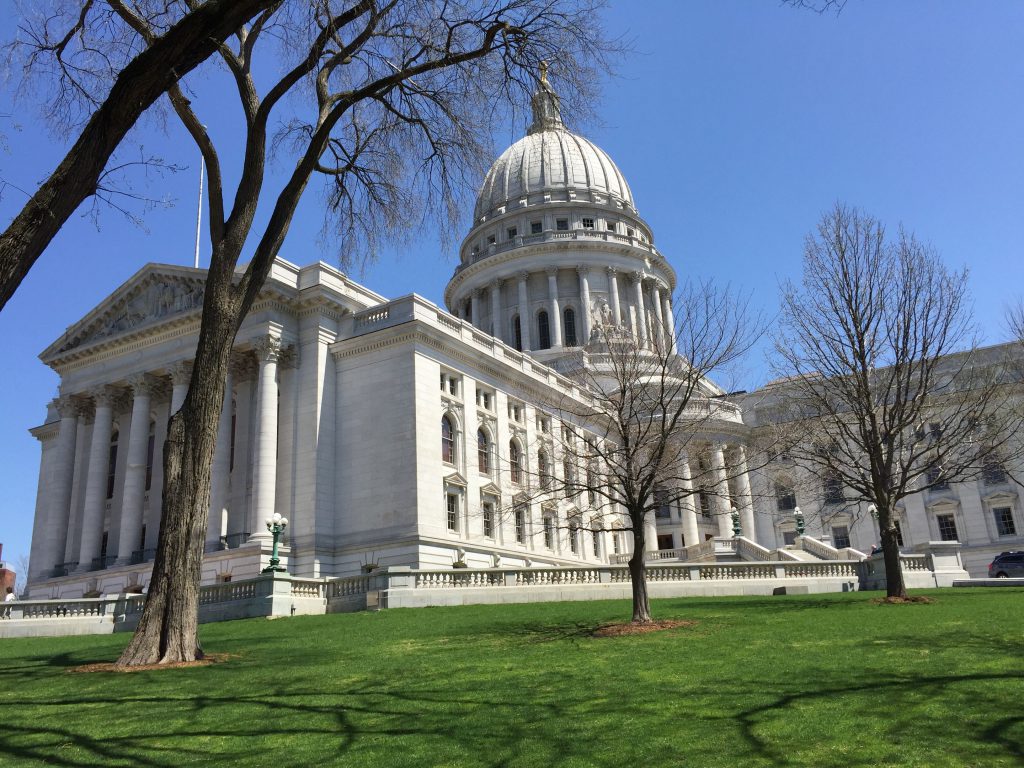State Budget Survives First COVID-19 Test
End of fiscal year budget total shows 1% gain. But more pandemic tests to come.
The first sign that COVID-19 didn’t — yet — put the state budget on a ventilator came last week. But the budget faces several positive-or-negative tests in the next few months.
Democratic Gov. Tony Evers, Republican legislators, leaders of school districts, local governments, health-care organizations and other special-interest groups must still worry about potential spending cuts in the current budget that ends June 30.
First, the good news. Two agencies, the Legislative Fiscal Bureau (LFB) and state Department of Revenue said general-fund tax collections for the year that ended June 30 increased by about 1 percent.
The pandemic shot Wisconsin’s unemployment rate up to a record 13.7 percent. It canceled hundreds of major tourism events — including the Democratic National Convention, Brewers and Bucks games, pro golf tournaments, Summerfest and the State Fair. The Milwaukee-area lost about 91,000 booked hotel rooms. A record number of unemployment Insurance claims swamped the state agency that oversees those benefits.
Those losses prompted “fiscal sky is falling” fears that general-fund taxes could fall by $2 billion, or about 11 percent.
Instead, the increase in tax collections means about $106 million will go into the budget stabilization fund — the state’s “break glass in case of emergency” fund. That fund will grow to $762 million, LFB reported. That’s $762 million that’s available to offset any pandemic-caused drop in tax collections in the current fiscal year.
LFB Director Bob Lang said tax collections “will likely be down” in the current year, although it’s too early to predict by how much. And, remember, the $112 million the state had expected to collect — and didn’t — last year means that cash isn’t available this year.
Republican Sen. Alberta Darling, cochair of the Joint Finance Committee (JFC), said the $106-million transfer to the rainy-day fund will help the state get through a difficult time without raising taxes, something Republicans who control the Legislature won’t do. “Because we were careful with the money taxpayers provided, our state finances are down, but not out,” she said.
Here’s the timeline in the watch for a potential budget crisis that threatens spending on K-12 schools, the UW System, health care and aid to local governments:
-Oct. 15: The State Department of Administration (DOA) publishes the official balance sheet for last year. It will score exactly how much state government spent, after Evers ordered emergency end-of-year savings, and reconciles that against the $17.53 billion in general-fund taxes that were collected. DOA’s report will establish what the cash-on-hand surplus was on July 1, heading into the current budget year.
-Nov. 20: DOA projects tax collections during the next two-year biennial budget, running from July 2021 through July 2023. Evers then issues budget guidelines to state agencies telling them how much to plan on cutting, or adding, in 2021-23 budget requests.
-January 2021: LFB tells legislators starting work on the 2021-23 budget how much they have to spend – or not spend – depending on any COVID-19 damage.
The non-profit Wisconsin Policy Forum reported last week that spending on K-12 schools could be most at-risk, if COVID-19 significantly cuts tax collections this year. The “heavy reliance on state support and policies places Wisconsin’s schools in a comparatively precarious position, even in the best of times,” the Policy Forum said.
There are two wild cards in all these budget “what ifs.”
First, how much will tax credits to Foxconn total? Two years ago, Republicans and Walker offered record cash to Foxconn for its giant details-to-come-later manufacturing plant Mt. Pleasant, and specified job targets for full-time employees Foxconn hired.
Second, will any new COVID-19 aid package from Washington — if Senate Republicans, House Democrats and President Trump can ever agree — include more aid for state governments?
Steven Walters is a senior producer for the nonprofit public affairs channel WisonsinEye. Contact him at stevenscotwalters@gmail.com
If you think stories like this are important, become a member of Urban Milwaukee and help support real, independent journalism. Plus you get some cool added benefits.
More about the Coronavirus Pandemic
- Governors Tony Evers, JB Pritzker, Tim Walz, and Gretchen Whitmer Issue a Joint Statement Concerning Reports that Donald Trump Gave Russian Dictator Putin American COVID-19 Supplies - Gov. Tony Evers - Oct 11th, 2024
- MHD Release: Milwaukee Health Department Launches COVID-19 Wastewater Testing Dashboard - City of Milwaukee Health Department - Jan 23rd, 2024
- Milwaukee County Announces New Policies Related to COVID-19 Pandemic - County Executive David Crowley - May 9th, 2023
- DHS Details End of Emergency COVID-19 Response - Wisconsin Department of Health Services - Apr 26th, 2023
- Milwaukee Health Department Announces Upcoming Changes to COVID-19 Services - City of Milwaukee Health Department - Mar 17th, 2023
- Fitzgerald Applauds Passage of COVID-19 Origin Act - U.S. Rep. Scott Fitzgerald - Mar 10th, 2023
- DHS Expands Free COVID-19 Testing Program - Wisconsin Department of Health Services - Feb 10th, 2023
- MKE County: COVID-19 Hospitalizations Rising - Graham Kilmer - Jan 16th, 2023
- Not Enough Getting Bivalent Booster Shots, State Health Officials Warn - Gaby Vinick - Dec 26th, 2022
- Nearly All Wisconsinites Age 6 Months and Older Now Eligible for Updated COVID-19 Vaccine - Wisconsin Department of Health Services - Dec 15th, 2022
Read more about Coronavirus Pandemic here
The State of Politics
-
RNC Brings Fame to Gen Z Party Leader
 Jul 15th, 2024 by Steven Walters
Jul 15th, 2024 by Steven Walters
-
Wisconsin’s Republican Roots Run Deep
 Jul 8th, 2024 by Steven Walters
Jul 8th, 2024 by Steven Walters
-
Feuding Supreme Court Justices Need a Break
 Jul 1st, 2024 by Steven Walters
Jul 1st, 2024 by Steven Walters






















